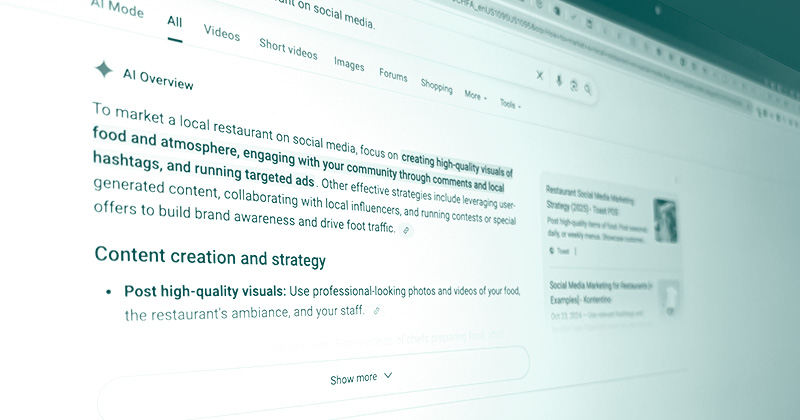By Kelly Heavican – Associate Media Director, Paid Search
Search has officially entered a new era. AI is no longer working behind the scenes; it now powers results, generates ads and delivers answers before audiences ever click on a single link. ChatGPT and other AI tools are challenging traditional search giants like Google, even as the latter is quickly evolving its own generative AI capabilities. For marketers, this shift introduces new challenges around visibility and competition, but it also creates new opportunities to connect with customers in more relevant and impactful ways.
The rise of AI overviews.
One of the biggest changes in search today is the rise of AI overviews (AIOs), which pull insights from multiple sources — like websites, social media posts and more — and combine them into a single, summarized response. These appear at the top of the search results page, providing quick, conversational answers to users’ queries.
This shift is redefining how users interact with search results. Instead of typing in a few keywords and getting back a list of links, searchers tend to interact with AI tools using natural language. For example, instead of “restaurant marketing,” they are more likely to use a long-tail term like “How to market a local restaurant on social media.”
AIOs are more likely to trigger for these question-style queries, and when they do, paid ads are pushed down the page. The result is less visibility for traditional ads and declining click-through rates. Recent research from Seer Interactive indicates that paid ad CTRs decrease from 21.27% to 9.87% when AIOs are triggered. However, it’s important to note that the same study found that AIOs only appeared in 7% of paid search results and accounted for just 2.2% of impressions.
How AI impacts paid search visibility and CTR.
For brands and marketing teams, the rise of AI in search brings challenges that can significantly affect campaign performance and overall reach.
- Less visibility.
Ads now appear below AI-generated summaries, reducing immediate visibility and engagement. Essentially, you’re paying for ads that fewer people see.
- Lower engagement and click-through rates (CTRs).
As users find quick answers in AI Overviews, CTRs are dropping — a shift that can negatively impact quality scores and overall campaign efficiency.
- Increased competition and costs.
With fewer premium ad slots available, more brands are vying for limited space. Expect higher costs and the need for more strategic bidding and targeting.
Five ways to adapt your paid search strategy for AI-driven search.
The brands that thrive in this evolving landscape will use AI to adapt quickly and proactively shape their strategies to align with this new search environment. At Ervin & Smith, we’re guiding clients through the AI revolution with strategies that help them stay ahead of the competition. Here’s how we’re doing it:
- Lean into automation.
Google’s AI-powered solutions, like Performance Max and smart bidding, utilize vast datasets and machine learning to optimize targeting, creative and budget allocation continuously. Think of AI as your creative teammate. With ChatGPT and Gemini, you can craft flexible headlines that echo the way people naturally speak and search online, ensuring your message resonates.
- Prioritize conversions over traffic.
Clicks and impressions aren’t the goal. Optimize for cost-per-acquisition (CPA) or return on ad spend (ROAS) to ensure your budgets fuel meaningful outcomes and directly contribute to your bottom line.
- Double down on intent-driven keywords.
AI often resolves general top-of-funnel queries, but when people search using high-intent terms like “buy,” “quote” or “price,” they’re ready to take action, and it requires a click. Build campaigns around these specific high-intent terms to connect with customers who are prepared to make a purchase or take a particular action.
- Leverage first-party data.
By segmenting audiences from your CRM or loyalty programs, you can guide Google’s AI toward users that mirror your best customers and make sure your ads are seen by those most likely to convert.
- Diversify your channel mix.
With shrinking SERP (search engine results page) real estate, invest incrementally in programmatic native, CTV and social platforms. A diversified approach ensures reach beyond Google while strengthening cross-channel visibility.
Looking ahead.
AI in search isn’t going away; in fact, it’s only expanding. OpenAI is already exploring e-commerce partnerships, and Google continues to infuse Gemini into its ad creation and targeting tools. The advantage will go to teams that combine paid search, content strategy and conversion optimization into one cohesive, AI-aware approach.
